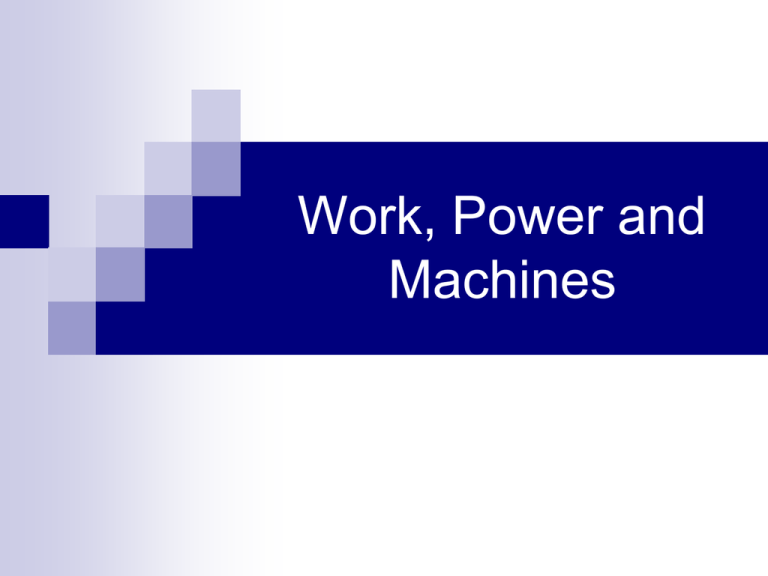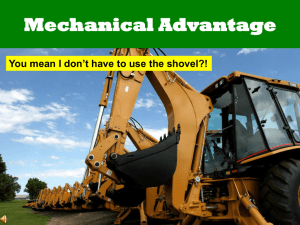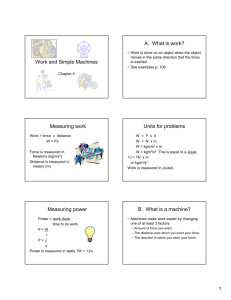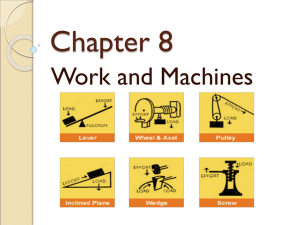Work, Power and Machines
advertisement

Work, Power and Machines Work Work- quantity of force applied over a distance. Is done when force causes motion of an object. Work equation: work = force x distance W=Fxd Always assume the force used to calculate work is pushing or pulling along the same line as the direction of motion. Work is measured in joules: The SI unit for work is joules (J), equal to 1 kg x m2/s2. That is: 1N x m= 1 J = 1 kg x m2/s2 Work Problems A crane uses an average force of 5200 N to lift a girder 25 m. How much work does the crane do on the girder? An apple weighing 1 N falls through a distance of 1 m. How much work is done on the apple by the force of gravity? While rowing in a race, John uses his arms to exert a force of 165 N per stroke while pulling the ore 0.800 m. How much work does he do in 30 strokes? Power http://hypertextbook.com/physics/mechanics/power/ Power measures the rate at which work is done, or how much work is done in a certain amount of time. Power equation: power = work / time or P = W / t Power is measured in watts. The SI unit for power is watts (W) and is the amount of power required to do 1 J of work in 1s. (About as much power as you need to lift an apple over your head in 1 s.) The watt is named after a Scottish inventor, James Watt, who played an important roll in the development of the steam engine. *** Be careful not to confuse work W with watts W.*** Power Problems While rowing across the lake during a race, John does 3960 J of work on the oars in 60.0 s. What is his power output in watts? Using a jack, a mechanic does 5350 J of work to lift a car 0.500 m in 50.0 s. What is the mechanic’s power output? Machines & Mechanical Advantage Machines help break down the work necessary to move an object. They do not increase the quantity of work that you can do… simply, they spread out the work over a longer distance reducing the force required to move the object. This is called multiplying the force (redirecting the force). Machines & Mechanical Advantage cont. Work input = work output. Machines do not reduce the amount of work required to move the object. If it requires 225 J to move the object… you will still have to use 225 J of work… a machine only reduces the force needed by spreading the force out over a longer distance. Mechanical advantage tells how much a machine multiplies force or increases distance. Mechanical advantage is a # which defines the ratio between the output force and the input force and is equal to the ratio between input distance and the output distance. Mechanical advantage= output F/ input F = input d / output d Fout / Fin = din / dout = M.A. The mechanical advantage has to be > 1 to multiply the force and help you move the object. http://www.physics.ohiostate.edu/~maryw/p103/overheads_pdf/Per7_over.pdf Mechanical Advantage Problems Calculate the Mechanical Advantage of a ramp that is 6.0m long and 1.5m high. Determine the M.A. of an automobile jack that lifts a 9900 N car with an input force of 150 N. SIMPLE MACHINES Simple Machines (SM) Simple Machines: one of the six types of machines of which all other machines are composed. (Remember that machines multiplies our force) There are 2 families of SM 1. The Lever Family: SM composed of three machines 2. The Incline Plane Family: SM composed of three machines The Lever Family Simple Lever: all levers have a rigid arm that turns around a point called a fulcrum. Force is transferred from one part of the arm to another. Levers are divided into 3 classes depending on the position of the fulcrum and of the input and output forces. 1. First class levers; Have fulcrum in the middle of the arm; the input force acts on one end, and the other end applies the output force. Ex. Claw hammer 2. Second class lever: the fulcrum is at one end of the arm and the input force is applied to the other end. Output force is somewhere in-between the fulcrum and the input force. Ex: Wheelbarrow 3. Third Class levers: these types of levers multiply distance rather than force- they have mechanical advantage of less than 1. The fulcrum is at one end of the arm, the input force is in the middle and the output force is at the other end of the arm. Ex. A broom or rake. Pulleys Pulleys are Modified Levers Single, Fixed Pulley Lifting a 100 N weight with a single, fixed pulley, the weight must be fully supported by the rope on each side of the pulley. This type of pulley has a MA of 1. Moving Pulley Using a moving pulley, the 100 N force is shared by two sections of rope pulling upward. The input force in the right side of the pulley has to support only half the weight. This pulley system has a MA of 2 Compound Pulley System In this arrangement of multiple pulleys, all of the sections of rope pull up against the downward pull of the weight. This gives an even higher MA. Ex: pulleys used to lift engines of cars. Wheel and Axle A wheel and axle is a lever or pulley connected to a shaft. A wheel and axle is made of a lever or a pulley (the wheel) connected to a shaft (the axle), as shown in the fig to left. INCLINE PLANE FAMILY There are 3 types: Incline planes: multiplies and redirects force. When pushing an object up a ramp you apply force parallel to the ramp. The ramp then redirects this force to lift the object upward. Wedge: this simple machine is a modified incline plane. It functions like two incline planes back to back. It turns a single downward force into two directed to the sides. A Ex. An axe blade screw is a incline plane wrapped around a cylinder. Compound Machines Compound Machine: a machine that is made of more than one simple machine: Ex. Scissors uses two first class levers joined at a common fulcrum. Car jacks….





